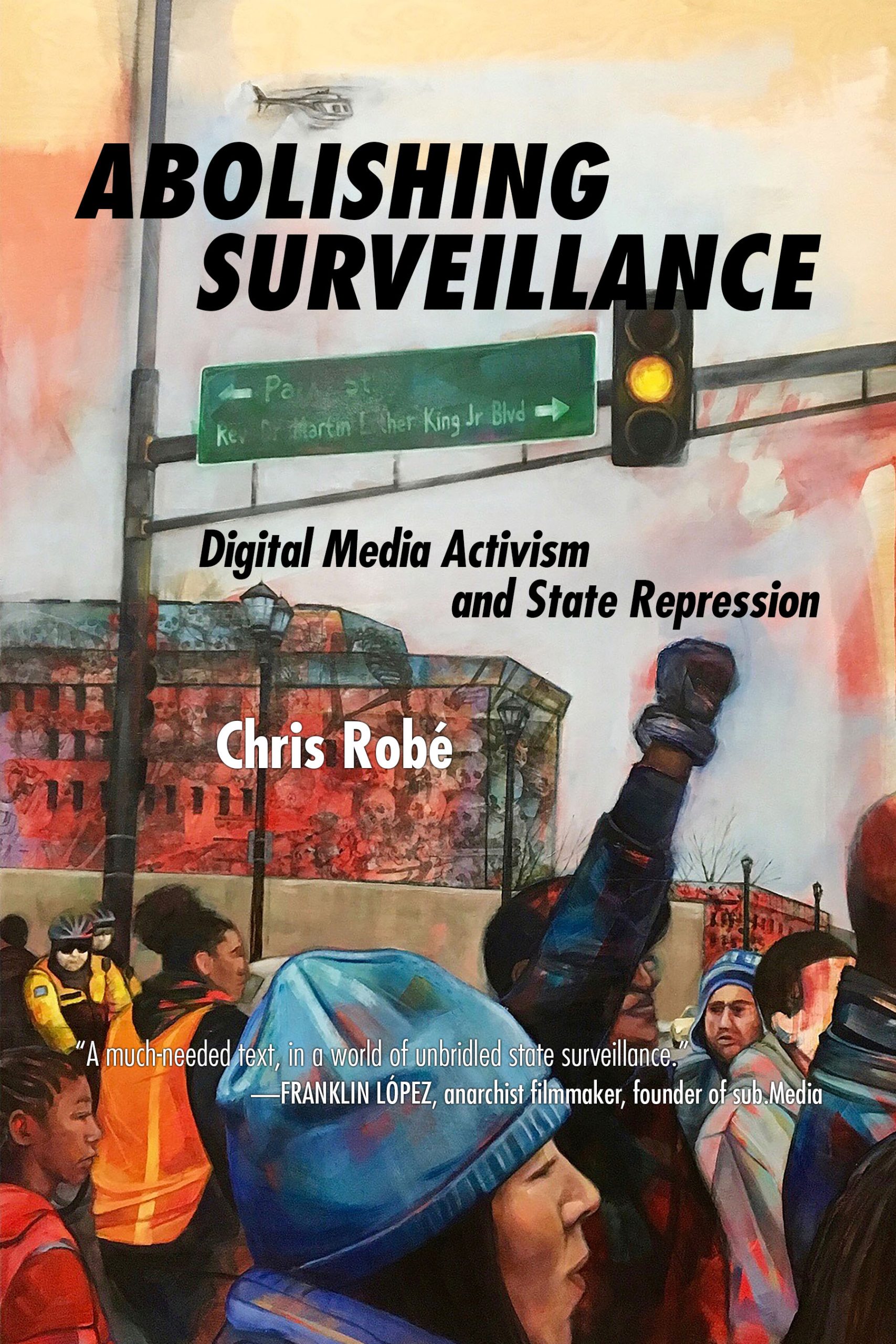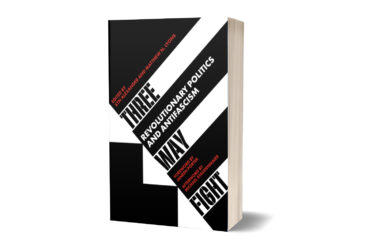The state spies upon and infiltrates social movements to keep people on guard, afraid, and second-guessing their every move.
An excerpt from Abolishing Surveillance: Digital Media Activism and State Repression by Chris Robe
Inquest
October 5th, 2023
St. Paul, Minnesota, police received $50 million from the federal government to spend on security for the 2008 Republican National Convention (RNC) there. By summer of 2007, local law enforcement had already begun to surveil protest groups in response to the appearance of the RNC Welcoming Committee website. The Welcoming Committee consisted of a group of mostly white, middle- to upper-class college-aged participants. Self-described anarchists, they were not engaged in any protest actions of their own, but assisted outside protest groups in coordinating their demonstrations. They did, however, help to establish what became known as the St. Paul principles. The principles supported a variety of protest actions taking place, from moderate ones, such as marching, to more aggressive ones, such as direct confrontation with the police. They also denounced any form of state repression, and demanded that criticism of protest actions remain internal.
The police became alarmed by the inflammatory rhetoric appearing on the RNC Welcoming Committee website, such as its insistence, “What we create here will send the convention crashing off course into insignificance.” Equally alarming to the police was a short promotional video produced by the RNC Welcoming Committee, “We’re Getting Ready.” The video self-mockingly portrayed the Twin Cities as solely occupied by black-clad and masked anarchists engaged in mundane actions such as eating breakfast, going to work, and raising kids. Blondie’s “One Way or Another” plays over the soundtrack as we follow one female anarchist to the convention center where the RNC will be held. By the video’s end, distant framing shows the edifice of the convention center dominating the screen, suggesting the convention’s oppressive and outsize presence. The video cuts to black, with white words announcing: “We’re Getting Ready / What Are You Doing?” The video directs the viewer to the RNC Welcoming Committee website (now defunct) for more information.
Video and digital media have become central activist tools in exposing state violence. Such media-making can be used to assist in organizing protests, provide evidence in court to clear protesters of inflated criminal charges, and help to organize support for those charged. Still, this same media can be used to provide ways for the state to infiltrate movements and undermine their credibility. The state has increasingly criminalized dissent by extending the definition of “domestic terrorism” to include many forms of civil disobedience and direct action, which has legitimized police actions such as attacking and arresting media-makers attending protests.
The RNC Welcoming Committee’s video inverts some of the derogatory clichés that haunt anarchists. For example, we see a masked woman with bolt cutters moving toward a fence, inviting the viewer to conclude that she is about to cut through the fence and invade someone’s property. But instead, she hands the cutters to another anarchist who uses them to trim nearby hedges. In another sequence, the same female anarchist is seen lighting a Molotov cocktail and lobbing it over a fence. But when the sequence cuts to over the fence, we see the Molotov land in an open BBQ, helpfully igniting it as a black-clad and masked anarchist in a chef’s hat gives a thumbs-up for the help. Gus Ganley, who shot the video, highlights its absurdist intentions: “Sarah Palin, she was the most absurd candidate at the time. The economic collapse was just about to erupt. We were living through absurd times. In the face of that widespread absurdity, there was no other way to respond but in kind.”
Despite the video’s playful tone, it ignited a $300,000 investigation into the Welcoming Committee and led to the infiltration of the group by a series of undercover officers along with law-enforcement recruitment of informers within. The Ramsey County police department became particularly alarmed at the presence of a Molotov cocktail in the video and used it as evidence to justify a series of raids and “preemptive” arrests the weekend before the convention, arresting the so-called “RNC 8” for their involvement in the Welcoming Committee.
The RNC 8 were Monica Bicking, Garrett Fitzgerald, Erik Oseland, Nathanael Secor, Eryn Trimmer, Luce Guillén-Givins, Rob Czernik, and Max Specktor. They were charged with enhanced terrorism for a “conspiracy to riot” and a “conspiracy to commit criminal damage to property in the first degree” as defined by Minnesota’s draconian state version of the Patriot Act.
More from our decarceral brainstorm
Every week, Inquest aims to bring you insights from people thinking through and working for a world without mass incarceration.
Sign up for our newsletter for the latest.
The search warrant for the raids notes, “During one scene, an individual (identified as Carrie Feldman by several sources) is seen throwing a Molotov cocktail.” Tellingly, the police apply a selective close reading of the video that excludes the sequence that follows, of the Molotov landing in a BBQ, which would have revealed the video’s humorous intentions. The reference to Molotov cocktails takes on particular importance, since the FBI used an informant to encourage some protesters to manufacture Molotov cocktails in order to justify state repression against them. According to Ganley, who filmed the video: “That was the smoking gun. It is lighting a grill. But according to the police, ‘They are preparing to light off Molotov cocktails.’ They set up the RNC 8 to be terrorist conspirators.”
The state manufactures and stresses the delinquency of anarchists to undermine the validity of certain protest movements. As philosopher Michel Foucault observes, the disciplinary apparatus of a punitive society does not attempt to quash delinquency. Instead it promotes delinquency—in order to profit from it and render more systemic resistance ineffectual. “It is not so much that [punitive societies] render docile those who are liable to transgress ‘the law,’” he notes. “But that they tend to assimilate the transgression of the law in a general tactics of subjection.” The defense against “anarchist hoodlums” has become one of the most significant alibis of the state in transferring enormous amounts of public money to private companies in order to further militarize police and cast a wider net of surveillance over public spaces.
When the RNC 8 were preemptively raided and arrested, the commercial press largely endorsed law enforcement’s actions, explaining that the inhabitants of the five houses that were raided were supposedly hoarding feces and urine and dismissed them as out-of-control anarchists. Law enforcement claimed to have “had information [urine] would be thrown at police during the convention.”
The threat of anarchists lobbing bodily waste at police has been a typical smear campaign used by police since the 1999 Seattle protests even though there has never been any evidence of this threat actually having been carried out. But as sociologist Lesley J. Wood has shown, such disinformation is a useful tactic in dehumanizing protesters and depoliticizing their actions, thus making their arrests seem justifiable to the general public.
Surveillance remains a deeply racialized practice. Tellingly, when authorities criminalize mostly young, white, middle- to upper-class protesters in order to defame them, they stress the protesters’ hidden and “nefarious” anarchist background, which holds certain bestial and racist connotations (such as the hoarding of bodily waste). Unlike when poor communities of color are targeted by the state and racial signifiers alone can speciously imply their links to criminality, the racial and class privileges of these protesters affords them a certain protection that most others do not share.
Before they were even arrested, the RNC 8 were already enmeshed in this system of surveillance more than they knew. Not only had the police been tracking them since 2007, following the appearance of the Welcoming Committee website, but a vast network of informers that initially focused on eco-activists—and was extended considerably after 9/11 (mainly to target Muslim Americans)—had already infiltrated their ranks. As Foucault notes, the use of informers and agents provocateurs is one of the most insidious ways to establish “a means of perpetual surveillance of the population; an apparatus that makes it possible to supervise, through the delinquents themselves, the whole social field.” The use of informers has exploded in numbers since 9/11. Whereas the government only employed around 1,500 informers in 1972, by 2014 there were roughly 15,000 in circulation.
This surveillance was not necessarily particularly well hidden, and psychological warfare was clearly part of its aim. Guillén-Givins, one of the RNC 8, recalls that prior to their arrest, “Many of us noticed being followed by squad cars, and cops would drive by our houses, shining searchlights into our yards and front windows and creeping along at a snail’s pace.” During her arrest, Bicking recalls Ramsey County sheriff Bob Fletcher taking her out of her cell and speaking with her in the middle of the block so that everyone could see them speaking together, leading to suspicions that Bicking might be assisting the police. She was then released before the first day of protests under the condition that she would try to deescalate, which she never agreed to do. Nonetheless, during her freedom, she observed: “I was in a constant state of fear. I was scared of being rearrested. I was scared that I would do something that would be construed as illegal. I was scared that I would be somewhere that would be raided. I was scared of running into the informants and of being followed.”
Police accountability activist Michelle Gross (now the administrator of the National Lawyers Guild – Minnesota Chapter) recalls the raid on their convergence center (where activists would meet, plan, and prepare materials) that happened before the first day of protests. The police blocked main roads to prevent many activists from even reaching the center. But for those who did, the police descended upon them, detaining them for hours with no proof of any illegal activity occurring. During her temporary detainment after the raid, Gross was unaware that her garage had been broken into by the police, who were searching frantically for any incriminating evidence. Luckily, her young daughter remained asleep in the house while the assault occurred. Gross recounts: “It pissed me off. I was so freaked out. I took her out of there and got a hotel way the hell out in the suburbs. I was petrified they would do something to her.”
The unified front among the RNC 8 was breached when Oseland pled guilty in August 2010, initiating the disintegration of solidarity among the RNC 8 and their support community. Fitzgerald, another RNC 8 member, recounts: I had hoped that taking our case to trial could be part of a shift in how radicals handled charges like ours. Much like how I, as part of the RNC [Welcoming Committee], wanted to encourage anarchists to think bigger and more strategically, I wanted our case to demonstrate another way to challenge the system of control we stand opposed to.
But with Oseland’s plea and the others following soon after, Fitzgerald asserts, “We lost credibility on that issue and demoralized supporters.”
The state employs a whole arsenal of disciplinary procedures against individuals. The courts, legal apparatus, informers, preemptive raids, and the like are not used merely to detain and temporarily incapacitate activists, but to work from within movements to instill fear, doubt, and suspicion that can hollow out the community.
Although many of the members of the RNC 8 have continued with their lives, and some continue to engage in activism, their experiences show the subtle ways in which disciplinary powers, such as surveillance, work in people’s lives to transform radical activists into disempowered and individualized bystanders.
This episode reveals the intense psychological warfare and coercive use of power that accompanies surveillance. Its purpose is to keep people on guard, afraid, and second-guessing their every move. Accusations of complicity are so damning that it doesn’t matter if they’re true or not—they’re taken as true. This is how surveillance operates: Guilt is assumed and innocence needs to be proven.





